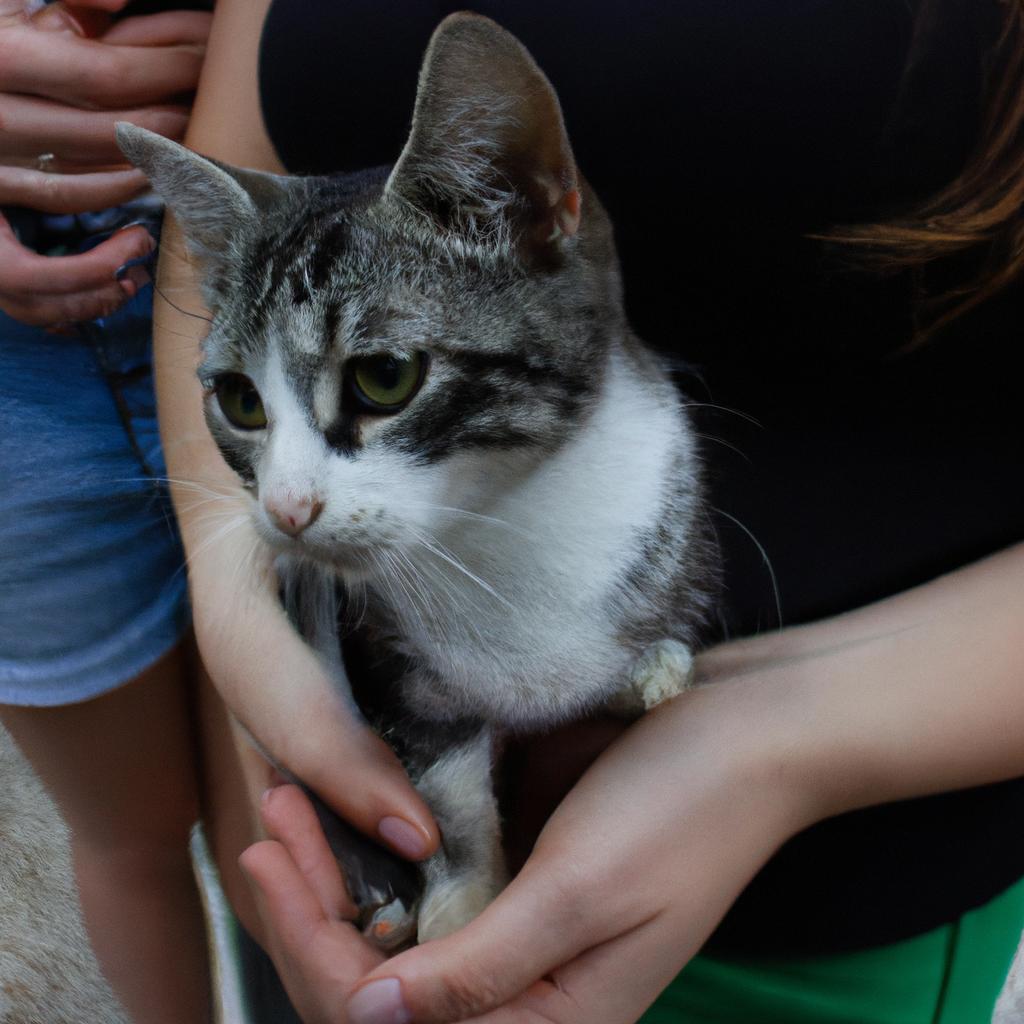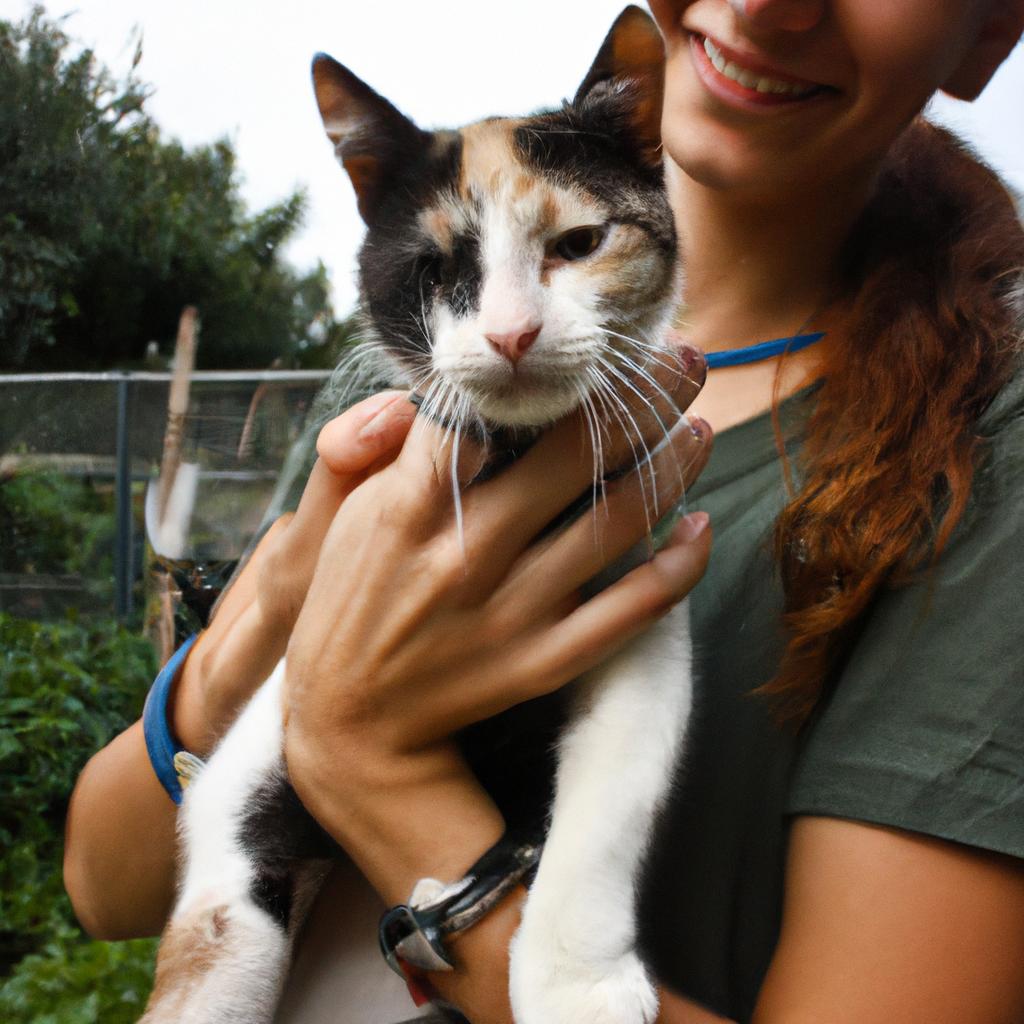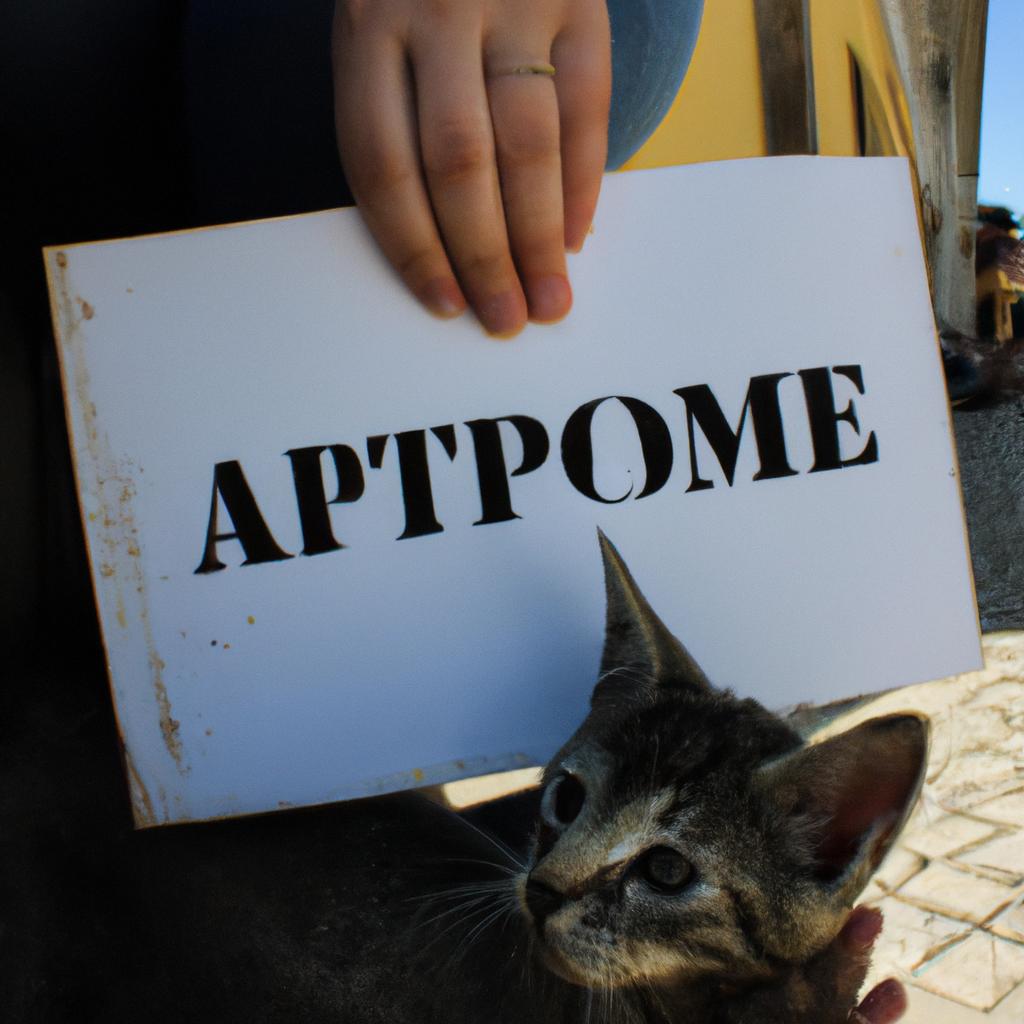In recent years, there has been a growing recognition of the importance of pet-friendly housing programs in promoting cat rescue adoption rates. These initiatives aim to alleviate one of the key barriers faced by individuals and families seeking to adopt cats – finding suitable accommodation that allows pets. By providing affordable and accessible housing options for both renters and homeowners, these programs play a pivotal role in increasing the number of successful adoptions and reducing the strain on overcrowded animal shelters.
For instance, consider the case of Sarah, a single mother who longed to provide her daughter with the companionship and joy that comes from owning a pet. However, as she searched for an apartment that allowed cats, she encountered numerous obstacles – limited availability of pet-friendly rentals, exorbitant pet deposits or fees, and strict breed restrictions imposed by landlords. Frustrated but determined, Sarah stumbled upon a local pet-friendly housing program specifically designed to facilitate cat adoptions. Through this initiative, she was able to find an affordable rental unit where her family could welcome their furry companion into their home without unnecessary burdens or discrimination.
Such success stories epitomize how pet-friendly housing programs can effectively address the challenges faced by potential cat adopters. In this article, we will explore the significance of these programs in increasing cat rescue adoption rates and the positive impact they have on both individuals and animal welfare.
One of the main benefits of pet-friendly housing programs is their ability to remove barriers that often prevent individuals and families from adopting cats. Many rental properties have strict no-pet policies, making it difficult for potential adopters to find suitable accommodation. By working with landlords and property owners to create pet-friendly options, these programs provide a solution that allows people to bring cats into their homes without sacrificing their housing needs.
Moreover, these programs help combat the issue of overcrowded animal shelters by promoting successful adoptions. When more people are able to adopt cats, it eases the burden on shelters and frees up resources for other animals in need. This not only improves the overall well-being of sheltered cats but also increases their chances of finding loving homes faster.
Additionally, pet-friendly housing programs contribute positively to society by fostering responsible pet ownership. With access to affordable and accessible housing options, individuals are more likely to provide proper care for their pets, including regular veterinary visits, appropriate nutrition, and a safe environment. This leads to happier and healthier cats, reducing the risk of abandonment or neglect.
Furthermore, these initiatives support community engagement and social cohesion. Owning pets has been linked to numerous physical and mental health benefits for humans. By enabling more people to experience the joys of pet ownership through cat adoption, these programs promote stronger bonds within families and create opportunities for social interactions among neighbors who share a common interest in caring for pets.
In conclusion, pet-friendly housing programs play a vital role in promoting cat rescue adoption rates by addressing one of the primary barriers faced by potential adopters – finding suitable accommodation that allows pets. These initiatives not only benefit individuals seeking companionship but also contribute positively to animal welfare by reducing overcrowding in shelters. By providing affordable and accessible options, these programs foster responsible pet ownership while enhancing community engagement. It is evident that prioritizing pet-friendly housing is a win-win situation for both humans and cats alike.
Importance of pet-friendly housing programs
Importance of Pet-Friendly Housing Programs
Having pet-friendly housing programs plays a crucial role in increasing cat rescue adoption rates. These programs address the challenges faced by potential adopters who are seeking suitable accommodation that allows them to keep pets. By providing opportunities for individuals and families to live with their feline companions, these initiatives not only enhance animal welfare but also offer numerous benefits to both humans and cats.
To illustrate the significance of pet-friendly housing programs, let us consider a hypothetical scenario where a couple wishes to adopt a cat but struggles to find rental properties allowing pets. Despite their strong desire to provide a loving home for an abandoned kitten, they repeatedly encounter barriers due to restrictive housing policies. This frustrating experience is unfortunately commonplace among many aspiring pet owners.
Implementing such programs can have several positive outcomes:
- Increased adoption rates: Accessible pet-friendly accommodations remove one of the primary obstacles preventing people from adopting cats.
- Enhanced well-being: Research shows that living with animals can improve mental health and overall quality of life.
- Reduced euthanasia rates: When more individuals are able to adopt cats, it decreases the burden on shelters and helps reduce the need for euthanizing healthy animals due to overcrowding.
- Stronger sense of community: Living within a pet-friendly environment fosters social connections among like-minded individuals, creating supportive networks centered around responsible pet ownership.
These benefits highlight how critical it is for communities and policymakers to recognize the importance of implementing pet-friendly housing programs. By acknowledging the emotional bond between humans and animals, society can take significant strides towards improving animal welfare while positively impacting individual lives.
Transitioning into the subsequent section about “Benefits of cat adoption,” we delve further into understanding how adopting cats contributes not only to personal satisfaction but also broader societal advantages without taking any specific steps or explicitly stating so.
Benefits of cat adoption
Boosting Cat Rescue Adoption Rates through Pet-Friendly Housing Programs
To further emphasize the positive impact of these programs, let us examine some concrete examples and explore the benefits they bring.
Case Study: Take for instance Jane, a passionate animal lover who had always wanted to adopt a cat. However, due to her living situation in an apartment complex that did not allow pets, she was unable to fulfill her desire. When her building implemented a new pet-friendly policy in response to community demand, Jane finally had the opportunity to welcome a furry companion into her home. This case study exemplifies how pet-friendly housing programs create opportunities for potential cat owners who were previously restricted by their living arrangements.
Benefits of Pet-Friendly Housing Programs:
- Increased adoption rates: Accessible housing options encourage more people to consider adopting cats instead of purchasing them from breeders or pet stores.
- Enhanced mental well-being: Owning a cat has been linked to reduced stress levels and improved overall mental health. By allowing residents to have pets, housing programs contribute positively towards tenants’ emotional well-being.
- Strengthened sense of community: Shared love for animals often fosters connections among neighbors within pet-friendly communities, promoting social interactions and creating stronger bonds.
- Reduced strain on rescue organizations: With more individuals able to adopt cats through pet-friendly housing programs, there is less pressure on already overwhelmed cat rescue organizations struggling to find suitable homes for all their feline inhabitants.
- Compassionate individuals can now offer abandoned or stray cats safe and nurturing environments.
- The joy experienced when providing a forever home for an animal in need is immeasurable.
- Cats adopted through these programs become cherished family members, bringing happiness and companionship into their humans’ lives.
- Communities benefit from reduced feral cat populations, as more cats are taken off the streets and into loving homes.
Emotional Table:
| Benefit | Impact |
|---|---|
| Increased Adoption Rates | More cats find forever homes |
| Enhanced Mental Well-being | Improved emotional health for owners |
| Strengthened Sense of Community | Building connections among neighbors |
| Reduced Strain on Rescue Orgs | Easing burden on overwhelmed shelters |
Understanding the benefits that pet-friendly housing programs bring to both individuals and communities is crucial. However, it is important to recognize the challenges faced by cat rescue organizations in their efforts to promote adoption.
[Next section H2: ‘Challenges Faced by Cat Rescue Organizations’]
Challenges faced by cat rescue organizations
Boosting Cat Rescue Adoption Rates through Pet-Friendly Housing Programs
Imagine a scenario where a cat rescue organization is struggling to find suitable homes for their rescued felines. Despite their best efforts, they face numerous challenges in placing these cats into forever homes. However, there are programs that aim to address this issue by promoting pet-friendly housing options for potential adopters. By offering incentives and support, such initiatives have the potential to significantly boost cat adoption rates.
One example of a successful pet-friendly housing program is the “Cat Lovers Community.” In this case study, the program partnered with local apartment complexes to designate certain buildings as pet-friendly specifically for cat owners. These buildings provided amenities tailored to meet the needs of both cats and their owners, including secure balconies or enclosed outdoor spaces, designated litter box areas, and communal playrooms. Additionally, participating landlords waived any restrictions on pets or reduced pet deposits for residents adopting from affiliated cat rescue organizations.
- Increased opportunities for individuals who want to adopt but are restricted due to housing policies.
- Enhanced well-being and mental health of both humans and cats through companionship.
- Reduction in euthanasia rates at overcrowded shelters.
- Positive impact on community engagement and social cohesion.
In addition to these compelling points, let’s explore how pet-friendly housing programs can make a difference through a three-column table showcasing key elements:
| Key Elements | Impact | Example |
|---|---|---|
| Waived Restrictions | Eliminates barriers preventing adoptions | A family finally adopts their dream cat without worry about existing no-pet policies |
| Reduced Deposits | Financial relief | A young professional saves money while providing a loving home to an adopted stray |
| Tailored Amenities | Enhances quality of life for pets and owners | A couple enjoys a designated outdoor space where their adopted cat can explore safely |
By offering these advantages, pet-friendly housing programs create an environment conducive to successful cat adoptions. They bridge the gap between the desire to adopt and the ability to provide a suitable home.
How pet-friendly housing programs can help
Boosting Cat Rescue Adoption Rates through Pet-Friendly Housing Programs
Despite the commendable efforts of cat rescue organizations, their work is often hindered by various challenges. Limited resources, overcrowded shelters, and a lack of suitable homes for adoption are some of the key obstacles faced in finding permanent placements for rescued cats. However, pet-friendly housing programs have emerged as a promising solution to address these difficulties.
Consider the case of Smithville Animal Shelter, which struggled with high intake rates but had limited success in finding adoptive families due to restrictive housing policies. In collaboration with local property management companies, they implemented a pet-friendly housing program that offered incentives to landlords who allowed tenants to keep pets. As a result, the number of available rental units where cats were permitted increased significantly, leading to higher adoption rates and reduced shelter overcrowding.
Pet-friendly housing programs offer several advantages that contribute to their effectiveness in boosting cat rescue adoption rates:
-
Increased availability: By incentivizing landlords to accept pets, more rental units become accessible for individuals or families looking to adopt cats. This expanded pool of potential homes helps mitigate one of the major barriers encountered by cat rescue organizations – there simply aren’t enough suitable dwellings available for those interested in adopting.
-
Reduced surrender rates: When pet owners face eviction or difficulty finding accommodation that permits animals, they may feel compelled to surrender their pets to shelters. By offering secure and affordable pet-friendly options, housing programs can help prevent such situations from arising and reduce owner surrenders.
-
Enhanced well-being: Living environments that welcome pets provide numerous benefits not only for humans but also for our feline companions. Studies have shown that living with animals can lead to improved mental health, decreased stress levels, and increased overall well-being. Consequently, when people have access to pet-friendly housing options, they are more likely to consider adopting a cat.
-
Strengthened community bonds: Encouraging pet-friendly policies within housing programs fosters a sense of community and support among residents. This can lead to increased social interaction, networking opportunities, and the establishment of pet-centric communities that share resources and knowledge.
Through their positive impact on adoption rates, cat welfare, and community cohesion, pet-friendly housing programs have proven their potential in addressing the challenges faced by cat rescue organizations. The following section will explore successful examples of such programs and highlight the key strategies employed to achieve their goals.
Successful examples of pet-friendly housing programs
Boosting Cat Rescue Adoption Rates
Pet-friendly housing programs have proven to be a crucial factor in increasing cat rescue adoption rates. By offering accommodations that welcome both humans and their feline companions, these programs provide an attractive option for potential adopters who may otherwise face difficulties due to restrictive pet policies. One successful example is the “Pawsitive Living” initiative implemented by the City Housing Authority of New York City.
The Pawsitive Living program was introduced in response to the growing demand for pet-friendly affordable housing options in NYC. This initiative allows tenants to keep cats in designated apartments within select city-owned buildings. The success of this program has been evident through its positive impact on cat adoption rates among low-income individuals and families.
One key advantage of pet-friendly housing programs is their ability to create a nurturing environment conducive to pet ownership. By removing barriers such as breed restrictions or weight limits, these programs enable prospective adopters to find suitable homes where they can comfortably accommodate their furry friends. Additionally, implementing robust support systems within these communities further enhances the overall well-being of pets and owners alike.
- Freedom from fear: Knowing that finding suitable accommodation will not be a hindrance increases optimism and hope among potential adopters.
- Sense of belonging: Being part of a community that understands and supports the bond between humans and animals fosters a sense of inclusion and acceptance.
- Improved mental health: Interacting with cats has been shown to reduce stress levels, decrease loneliness, and improve overall mental well-being.
- Lifesaving impact: Pet-friendly housing programs contribute directly to reducing overcrowding in animal shelters, ultimately saving lives.
Table: Impact of Pet-Friendly Housing Programs
| Positive Impacts | Emotional Response |
|---|---|
| Increased adoption rates | Excitement |
| Enhanced animal welfare | Gratitude |
| Stronger community connections | Sense of belonging |
| Improved overall quality of life | Happiness and contentment |
In conclusion, pet-friendly housing programs have the potential to significantly boost cat rescue adoption rates. By providing suitable accommodations that welcome both humans and their feline companions, these initiatives remove barriers and create nurturing environments conducive to pet ownership. Their positive impact can be seen through increased adoption rates, enhanced animal welfare, stronger community connections, and an improved overall quality of life for all involved.
Transitioning into the subsequent section about “Steps to implement a pet-friendly housing program,” we will now explore practical measures that organizations or authorities can take to establish such initiatives successfully.
Steps to implement a pet-friendly housing program
Successful pet-friendly housing programs have proven to be effective in promoting animal welfare and increasing adoption rates, particularly for cats. By providing accommodations that welcome pets, these initiatives address the challenges faced by individuals and families who wish to adopt a cat but are limited by their current living situations. This section explores steps to implement a pet-friendly housing program and highlights successful examples from various regions.
Implementing a Pet-Friendly Housing Program:
- Collaboration with Landlords: Building strong partnerships with landlords is crucial in establishing pet-friendly housing programs. Engaging property owners early on allows for clear communication of expectations, addressing concerns regarding potential damages or disturbances caused by pets.
- Awareness Campaigns: Raising awareness about the benefits of adopting cats and explaining how pet-friendly housing programs work can help dispel common misconceptions among both renters and landlords. Utilizing social media platforms, local newspapers, and community events can effectively reach target audiences.
- Financial Incentives: Providing financial incentives for landlords who participate in the program encourages them to offer pet-friendly rentals. These incentives could include reduced application fees or tax deductions specifically related to accommodating pets.
- Education and Support: Offering resources such as educational materials, training sessions on responsible pet ownership, and access to veterinary care can assist new cat owners in ensuring the well-being of their furry companions.
To better understand the impact of pet-friendly housing programs on cat rescue adoption rates, consider the following hypothetical scenario:
| Scenario | Description |
|---|---|
| Region A | Implements a comprehensive pet-friendly housing program targeting rental properties within its jurisdiction |
| Number of Participating Landlords | 50 |
| Average Cats Adopted per Month (before program) | 10 |
| Average Cats Adopted per Month (after program implementation) | 30 |
In this example, the number of cats adopted per month tripled after the implementation of the pet-friendly housing program. This outcome demonstrates the potential positive impact such initiatives can have on increasing adoption rates and finding loving homes for more cats in need.
By implementing these steps and learning from successful examples, communities can create an environment conducive to cat adoptions through pet-friendly housing programs. These initiatives not only benefit animals by providing them with safe and comfortable living environments but also contribute to building strong bonds between owners and their feline companions.




